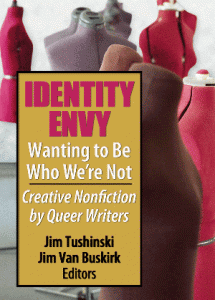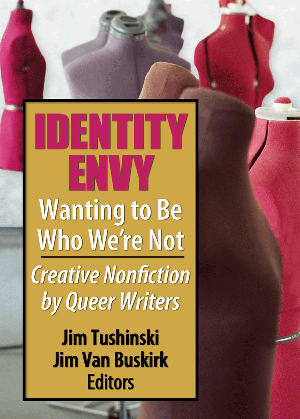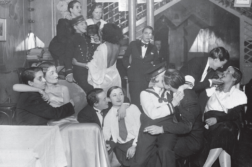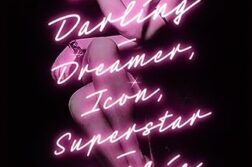 Identity Envy: Wanting to Be Who We’re Not: Creative Nonfiction by Queer Writers
Identity Envy: Wanting to Be Who We’re Not: Creative Nonfiction by Queer Writers
Edited by Jim Tushinski
and Jim Van Buskirk
Harrington Park. 267 pages, $44.95
THIS IS an eclectic anthology of engaging essays and memoirs whose message is that the desire to be someone other than who we are is an integral and universal aspect of coming of age. Editors Jim Tushinski and Jim Van Buskirk solicited essays on the belief that queer writers are particularly attuned to the experience of marginalization and the process of negotiating one’s identity amid competing expectations and needs. The impulse to find one’s place in the larger culture—and the negotiations that the self makes while on this quest—is a central focus of these contributions.
These authors share the experience of having grown up in North America in the second half of the 20th century in a cultural milieu that made them feel marked and “other.” Although never explicitly defined, “identity envy” is tied to the process of individuation by which the adolescent begins to construct a world view and a sense of self as separate from one’s family of origin. The different authors illuminate the complex ways in which race, gender, ethnicity, class, religion, and national identity were de- and re-constructed by their adolescent and young adult selves.
For many of these writers, the earliest experience of identity envy involved a yearning for certain physical qualities other than one’s own, in some cases to erase the emblems of one’s outsider status. In “The Day My Past Came Calling,” Jay Blotchier confesses that for as long as he can remember, he wanted in effect to look like a Ken doll: “I wanted piercing blue eyes and a shock of blond hair that would constantly fall over my high forehead into my eyes, requiring me to shake it back with a practiced insouciance.” An adoptee, Jay is painfully aware that his light brown skin marks him as different from his suburban Jewish peers. Years later, his birth mother makes contact and he immerses himself in his mother’s white family and his father’s Puerto Rican family and begins to overcome the feeling of being a misfit that he could never quite shake.
For other writers, the path to self-acceptance is necessarily one of defiance against damaging stereotypes. Memoirist Jeff Mann, a West Virginia academic and self-described “hillbilly,” admits in his wry memoir that he’s a “hive of hopeless contradictions.” His childhood preoccupation with all things aristocratic was a way to separate himself from his less sophisticated peers—and to express his yet-unnamed homosexuality. Later, after he builds an academic career on Appalachian and queer studies and moves in with his life partner, he can embrace his taste for the æsthetics of castle plantations while acknowledging the “social injustice, class differences, and unequal distribution of wealth” that make them possible.
In a similar vein, JD Guilford’s “Pimp Juice” includes a confession that he’s found it difficult to accept himself as a New Black Homosexual, “complete with dreadlocks, too-tight jeans, and rainbow key chain (sparkly bracelets and corset-blazer each sold separately).” Guilford learns to embrace his “new liberal gay” identity only after shaking off the stigmas of childhood, coming out, and becoming socially and politically active. But, he admits, he still finds himself capable of withering under the disapproval of other blacks: “My heart still does a triple lutz when I walk past a group of b-boys, and I still feel remorseful when I meet a black woman’s disapproving eyes.” Guilford concludes that homosexuality and black consciousness are not mutually exclusive and will “exist in perfect symbiosis within me … as long as my heart pumps in my chest.” Identity envy, for Guilford, involves an ongoing struggle to express both his gay pride and his black pride in the face of judgment and harassment.
Raised a French-Canadian Catholic in 1950’s Québec, Robert Boulanger describes his adolescent attraction to and pursuit of American men, which he now sees as a means of escape from his suffocating familial and social limits. Having internalized the identity of French Canadians as second-class citizens, he regarded sex with American men as a way to level the playing field. His vocational, sexual, and geographic wanderings seem resolved when he joins the U.S. Army. As a new soldier, his manner of walking and talking is noticed by his comrades, who chalk it up to his being “French.” In the end, the successful Army experience sanctions his new national identity and enables him to become the kind of American man he has always longed for—and to attract the kind of men he desires.
In “Chasing the Grasshopper,” Gerard Wozeck embarks on a similar path to sexual and social self-acceptance through his obsession with Caine, the protagonist of the 1970’s TV show Kung Fu. Wozeck describes his fifteen-year-old self as a “willowy teenager mired in adolescent acne in the repressed outskirts of Chicago, in a long distance love affair with Caine.” The fantasy of becoming lovers with Caine serves not only as an outlet for his sexual yearnings but also as an expression of his deep identification with a renegade outsider whose mixed racial identity and personal philosophy of harmonious love allow him to triumph when confronted by prejudice and ostracism.
Of the creative nonfiction entries in this anthology, the imaginative prose poem by Darin Beasley sparkles brightly. Its third-person narration and light touch give it a fairy tale quality—but it’s a deeply felt, heartbreaking account of two lovers that illustrates the inevitable tensions and wayward trajectory of a significant love affair. “Keith loved Darin. Darin could close his eyes at night and recount Keith by heart. The stories that happen can go wrong. Instead of hanging back like reluctant boys might, they were brave. They were a sacrilegious pair, foolish and headstrong, one with hazel-colored eyes and the other blue. It sounds dreamy. It was.” With a flair for irony and humor, Beasley is keenly aware of the self-destructive side of obsession with another person that threatens to swallow the self. Identity envy can be a natural urge in the path toward individuation, but it can also be a dark impulse that threatens the boundaries between self and other.
One glaring problem with this collection is the uneven blend of male and female voices. Around one-quarter of the 28 pieces are by women; in their introduction, the editors anticipate some criticism on this point but explain that this mix reflects the proportion of submissions by gender. (But this doesn’t explain why the editors didn’t make a concerted effort to solicit more manuscripts from women.) Margaret Cleaver contributes an important philosophical perspective in her essay about the perennial school library assignment entitled “Who Am I?” Cleaver wonders how she can possibly name and describe the “central, deeper version of myself which I imagine that only I can see” without any reference to people, places, or events outside herself. “Is there such a thing as an identity based on an essence of ‘selfness’ which is not a collection of the attributes that assign one to a particular social group?” she wonders. “Is there such a thing as an essence of ‘selfness’ which is always present within one’s being from the time of birth until death? And if it is possible to discover this ‘essence’ within one’s ‘self,’ how can it be described in such a way that others can understand it, relate to it, call it, name it? Because mustn’t there always be the ‘others’ who create that ‘adversity’ by which we ultimately define ourselves?”
Cleaver’s questions point to the central theme of this book. Is it possible to know and identify ourselves without recourse to labels, categories, and stereotypes? This anthology suggests that looking outside oneself to understand the self is an inevitable part of the human condition, regardless of your sexual orientation. When children, adolescents, and young adults experience intense and overwhelming feelings of longing, self doubt, fantasy, and even lust, these are important signposts on the perilous pathway toward recognition and acceptance of their core selves. Wildly diverse and achingly honest, the essays that make up this original anthology offer new perspectives on the reasons and rewards for wanting to be who we are not.
Patricia R. Payette teaches in the freshman seminar program at Michigan State University.






